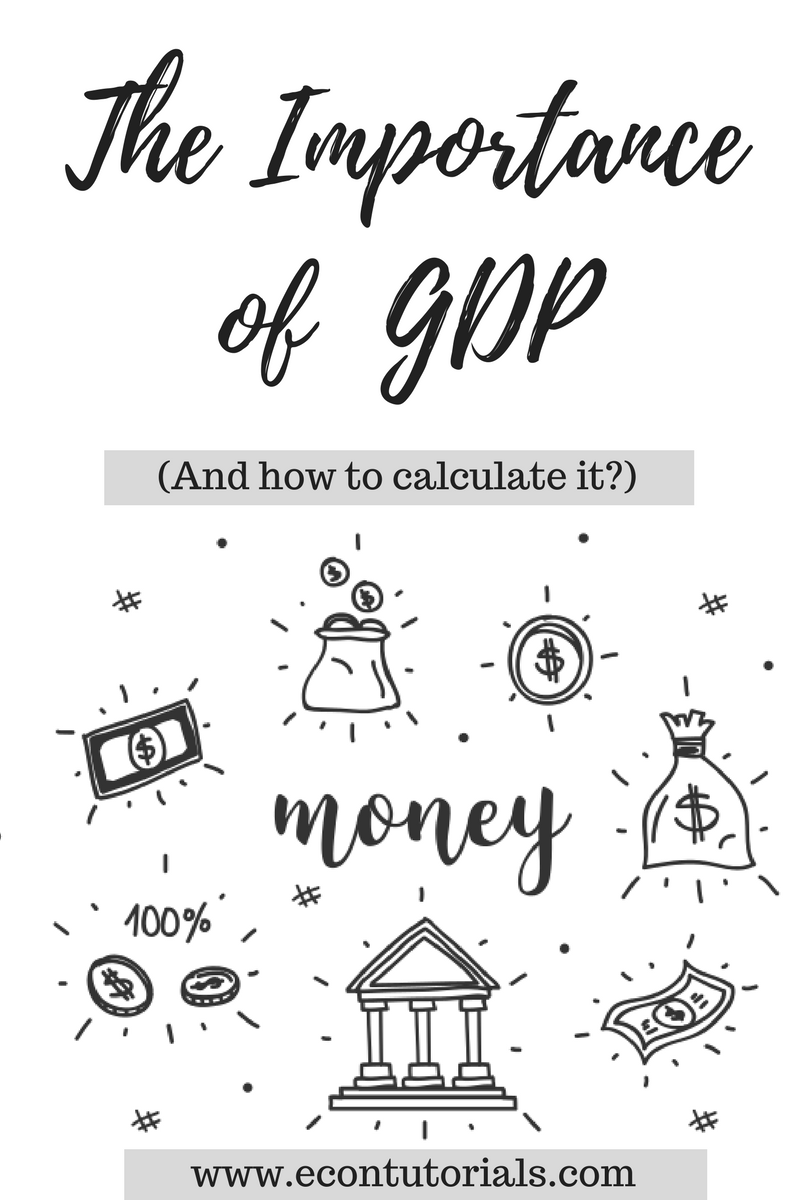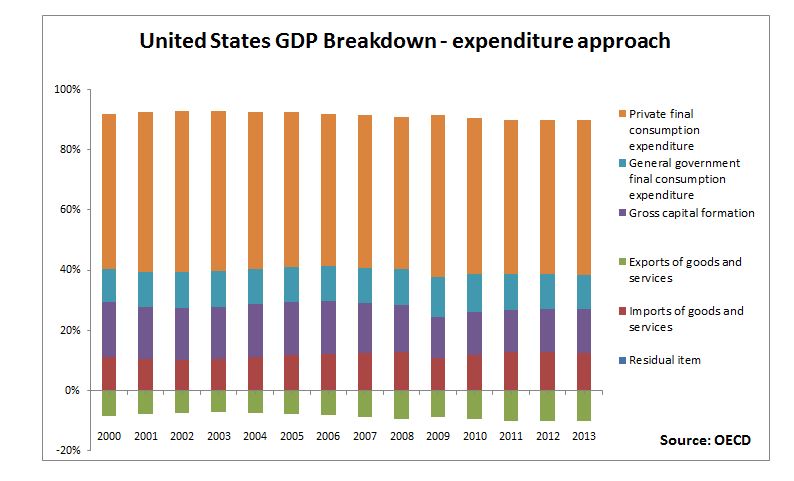One of the most common ways to measure the size of an economy, in other words, the aggregate output of a country, is by compiling the gross domestic product (GDP). As defined by the World Bank, GDP represents the market value of all final goods and services produced within a country’s borders, during the course of one year.
However, this definition often called the production approach (or the output approach) is not the only way to compile GDP.
OECD proposes a different approach to GDP since it shows that GDP can also be calculated as the sum of the gross value added of all resident institutional units engaged in production to which we need to add taxes and subtract any subsidies on products not included in the value of their outputs.
This is called the income approach in the specialized literature. Yet another method of calculating GDP is the expenditure approach, defined as the sum of the final uses of goods and services (all uses except intermediate consumption) measured in purchasers’ prices, less the value of imports of goods and services, or the sum of primary incomes distributed by resident producer units.
Let us understand the key terms before we explain these approaches briefly.
Key terms
- Final Goods and Services: Goods and services produced for final usage (by the consumer)
- Intermediate Goods: Goods that are used for processing of other goods. Or you can say goods that are produced by firms for further use of other firms.
- Value Added: It is the difference between Value of Good as they leave a stage of production to another and the cost of that good as they entered that stage. Read the complete details of the concept below.

Three methods of calculating GDP
The Production (output) approach
This method of compiling GDP leads to counting the production by sector of activity. Most countries using this approach extrapolate value added with tools such as the Index of Industrial Production (IIP), physical quantity indicators or sales type statistics for estimates of value added in manufacturing.
While most countries still use the production approach since 1979, one major drawback of this method is the difficulty to differentiate between intermediate and final goods. This is why some countries such as the United States and Japan prefer other methods, like the income or the expenditure approach.
The Income approach
This method of calculating GDP refers to compiling data from employment and earnings surveys to estimate salaries and wages by industrial activity. However, there are sectors of activity for which it is not easy to measure compensation.
Therefore, many countries such as Canada, the United States, Japan or Australia use the income approach through trend extrapolation to estimate GDP.
This includes the following:
- Compensation of Employees (wages, salaries etc)
- Proprietor’s Income (Unincorporated business income)
- Rental Income (Property owner income)
- Personal Income
- Disposable Income (After Tax income)
- Corporate Profits (From corporate business)
- Net Interest (paid interest by business)
- Indirect taxes – subsidies (Sales tax, customs duty and other fees – subsidies that the government pays)
- Net business transfer payments (Transfer payments from one business to another)
- Surplus of Government enterprises (Govt entities income) etc
The Expenditure approach
Although the two approaches presented above are still popular, the most widely used approach to measure GDP is the expenditure approach.
This method suggests to simply look at how much do households, government, non-profit institutions, and financial institutions consume within a country to which one must add the net exports of that country.
There are 4 categories of Expenditure
- Personal Consumption made by households
- The gross private domestic investment that is the spending by firms and households in new capital. for example Inventory, residential infrastructure, plant etc.
- Gross Investment and consumption by the Government
- Net Export that equals Exports minus Imports
The formula for calculating GDP, using the expenditure approach is the following:
GDP = C + I + G + (X- M)
- C = Private consumption expenditure
- I = Investment Expenditure
- G= Government Consumption Expenditure
- X = Value of Exports
- M = Value of Imports
The expenditure approach not only facilitates the compilation of GDP, but it can also offer insights on the economic policies of a country, like in the graph below (source: OECD)

NOTE: GDP is only concerned with NEW and FINAL Production. It excludes:
- Used Goods and Paper transactions
- Output produced in another country that is owned by domestic factors of production (that’s GNP)
References: 
Principles of Macroeconomics
Mankiw, N. G. (2008). Principles of macroeconomics. Toronto: Thomson Nelson.
Ons.gov.uk. (2013). Understanding GDP and how it is measured – ONS. [online] Available at:
http://www.ons.gov.uk/ons/rel/elmr/explaining-economic-statistics/understanding-gdp-and-how-it-is-measured/sty-understanding-gdp.html [Accessed 23 Apr. 2015].



Wonderful beat ! I would like to apprentice at the same time as you amend your site,
how could i subscribe for a weblog site? The account helped me a appropriate
deal. I had been a little bit familiar of this your broadcast
provided bright transparent idea
Feel free to surf to my web blog Nordvpn Coupons Inspiresensation (T.Co)
Hello there! This is kind of off topic but I need some help from an established blog. Is it difficult to set up your own blog? I’m not very techincal but I can figure things out pretty fast. I’m thinking about setting up my own but I’m not sure where to begin. Do you have any points or suggestions? Appreciate it
Howdy! Do you use Twitter? I’d like to follow you if that would be ok. I’m absolutely enjoying your blog and look forward to new posts.
I want to show my respect for your generosity supporting persons that actually need help on your concern. Your very own dedication to passing the solution throughout appears to be extremely interesting and has really empowered professionals like me to achieve their goals. Your new invaluable hints and tips can mean a great deal a person like me and even more to my fellow workers. Warm regards; from all of us.
My partner and I stumbled over here different web page and thought I might check things out. I like what I see so i am just following you. Look forward to looking over your web page for a second time.
Really wonderful visual appeal on this site, I’d rate it 10 10.
Hello, Neat post. There is a problem together with your site in internet explorer, might test thisK IE still is the market leader and a large component to other folks will miss your magnificent writing due to this problem.
Howdy! I just would like to give an enormous thumbs up for the great info you will have here on this post. I will be coming again to your blog for extra soon.
Greetings! I’ve been reading your website for a while now and finally got the bravery to go ahead and give you a shout out from Kingwood Texas! Just wanted to tell you keep up the good work!
I will immediately grab your rss as I can’t find your e-mail subscription hyperlink or e-newsletter service. Do you’ve any? Please allow me realize so that I may just subscribe. Thanks.
I like this blog very much, Its a very nice post to read and incur information.
I love the efforts you have put in this, appreciate it for all the great articles.
I’m very happy to read this. This is the kind of manual that needs to be given and not the accidental misinformation that is at the other blogs. Appreciate your sharing this best doc.
I’d incessantly want to be update on new articles on this internet site, saved to bookmarks! .
I needed to put you that very small note to finally say thanks over again for your marvelous advice you have discussed above. It has been so shockingly open-handed with you to supply unhampered precisely what a number of us might have advertised as an ebook in order to make some money on their own, primarily since you could have tried it if you desired. These secrets likewise worked to become good way to realize that most people have similar fervor much like my very own to grasp more on the topic of this problem. Certainly there are several more pleasant instances ahead for those who start reading your blog.
I have been exploring for a little for any high-quality articles or blog posts in this sort of house . Exploring in Yahoo I finally stumbled upon this web site. Reading this information So i am satisfied to express that I have a very excellent uncanny feeling I discovered exactly what I needed. I such a lot unquestionably will make sure to do not forget this website and provides it a look regularly.
The information shared is of top quality which has to get appreciated at all levels. Well done…
Thank you for sharing indeed great looking !
As I website owner I conceive the subject material here is really good, thanks for your efforts.
Hi there! This post couldn’t be written any better! Reading through this post reminds me of my old room mate! He always kept chatting about this. I will forward this post to him. Fairly certain he will have a good read. Thank you for sharing!
Hi would you mind letting me know which webhost you’re using? I’ve loaded your blog in 3 completely different internet browsers and I must say this blog loads a lot quicker then most. Can you recommend a good web hosting provider at a reasonable price? Thanks, I appreciate it!
What i don’t understood is if truth be told how you’re not actually much more well-liked than you may be right now. You’re very intelligent. You already know therefore considerably when it comes to this subject, produced me in my view imagine it from numerous varied angles. Its like women and men are not interested except it¦s one thing to accomplish with Woman gaga! Your own stuffs excellent. Always maintain it up!
We are a group of volunteers and opening a new scheme in our community. Your site offered us with valuable info to work on. You have done an impressive job and our whole community will be thankful to you.
This is the appropriate weblog for anyone who needs to seek out out about this topic. You notice so much its virtually hard to argue with you (not that I truly would need…HaHa). You positively put a brand new spin on a topic thats been written about for years. Great stuff, simply great!
great points altogether, you just gained a brand new reader. What would you recommend about your post that you made some days ago? Any positive?
Wonderful paintings! That is the kind of info that are supposed to be shared around the net. Shame on Google for now not positioning this post higher! Come on over and visit my web site . Thanks =)
Zikomo kwambili, This has helped. Pheeew